 October 4, 2025
October 4, 2025 October 4, 2025
October 4, 2025
Hey, Task Force: Prop. D LOST. Implement Prop. E! It won.
Voters Double-Crossed at Commission Streamlining Task Force
Circumvention: Commission Streamlining Task Force “Off the Rails”
Weakening commissions is precisely what the Task Force is
doing to hand Mayor Lurie more strong mayor authority.
Prop. E was supposed to be a “hedge” against a “strong mayor.”
The Task Force is recommending implementing the opposite!
Alarm Bells for Democracy:
“Resetting the City’s Governance Structure” and
Restricting Placing Future Ballot Measures
by Patrick Monette-Shaw
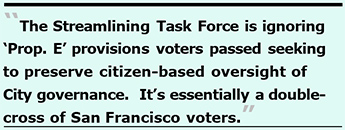 The “Commission Streamlining Task Force” mandated by Proposition E that voters passed in November 2024 is continuing to face community concerns via public testimony that the Task Force is implementing “Prop. D” style reforms to hand stronger powers to San Francisco’s Mayor that was rejected by voters. The Task Force is ignoring “Prop. E” provisions voters passed seeking to preserve citizen-based oversight of City governance.
The “Commission Streamlining Task Force” mandated by Proposition E that voters passed in November 2024 is continuing to face community concerns via public testimony that the Task Force is implementing “Prop. D” style reforms to hand stronger powers to San Francisco’s Mayor that was rejected by voters. The Task Force is ignoring “Prop. E” provisions voters passed seeking to preserve citizen-based oversight of City governance.
It’s essentially a double-cross of San Francisco voters.
So far, the Task Force has voted to eliminate a total of 51 bodies, and combine three others with other bodies, effectively eliminating 54 bodies as of October 1, saving at first glance about $1.6 million in City expenses. If only those cost savings were true. (They actually aren’t, discussed below!)
On October 15, the Task Force will consider eliminating 5 more bodies, combining or eliminating 8 other bodies, and consider keeping 17 bodies, when it deliberates over what to do with 30 Boards and Commissions in the “Public Health and Wellbeing” policy category. And they’ll consider what to do with the final 23 bodies on November 5 in the “General Administration and Finance Category” that they have not yet released recommendations about what to do with them.
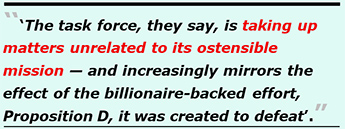 The proponents and backers of “Prop. D” had called for wholesale elimination of 65 policy bodies, so the Task Force is well on its way to surpassing elimination of at least 65 bodies, if not more, since it still has 53 bodies to evaluate and vote on, on October 15 and November 5. The “Prop. D” proponents are likely dancing in the streets. “Prop. E” voters? Not so much!
The proponents and backers of “Prop. D” had called for wholesale elimination of 65 policy bodies, so the Task Force is well on its way to surpassing elimination of at least 65 bodies, if not more, since it still has 53 bodies to evaluate and vote on, on October 15 and November 5. The “Prop. D” proponents are likely dancing in the streets. “Prop. E” voters? Not so much!
On October 3, Mission Local’s reporter Xueer Lu, who covers City Hall, published a terrific article titled “Prop. E was supposed to rein in S.F. mayor’s power. Instead, it’s recommending the opposite.” Although the title is a mouthful, it summarizes well her terrifically written article! She wrote, in part:
“Much like democracy, it [the Task Force’s deliberations] is getting messy. People who campaigned for Proposition E, which created the task force, now say that it has gone off the rails. The task force, they say, is taking up matters unrelated to its ostensible mission — and increasingly mirrors the effect of the billionaire-backed effort, Proposition D, it was created to defeat.”
Ms. Lu graduated from UC Berkeley Graduate School of Journalism with a master’s degree in May 2023.
Lu is right. The Task Force waded into the issue of employee discipline at the Police department and Fire Department, for one thing that it had no business wading into. That appears to be beyond the remit voters approved with passage of “Prop. E.” Among other things, the Task Force has also inserted itself into asserting that appeals of decisions made by City Departments need to be moved away to another public body to create separation and “neutrality.”
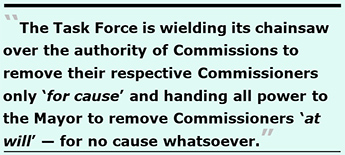 Lu even quotes Task Force Chair Harrington as having said that empowering the Task Force to recommend changing, eliminating, or combining City commissions does give the Task Force the ability to weaken commissions in ways that are “pretty similar to what Prop. D would have done.”
Lu even quotes Task Force Chair Harrington as having said that empowering the Task Force to recommend changing, eliminating, or combining City commissions does give the Task Force the ability to weaken commissions in ways that are “pretty similar to what Prop. D would have done.”
“Weakening” commissions is precisely what the Task Force is doing in multiple ways, in order to hand Mayor Lurie more “strong mayor” authority. While “Prop. E” was supposed to be a “hedge” against a “strong mayor,” the “Prop. E” Task Force is recommending implementing the exact opposite, as Lu clearly reveals!
Those aren’t the only things the Task Force has done crashing off the rails of its mission. If you haven’t already read Lu’s article, it’s recommended as must reading!
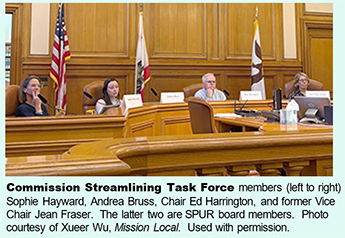
Chainsaw Wreckage to Date
Ms. Wu noted that “by design” the Streamlining Task Force is stocked with representatives of different City departments. A better word is “stacked,” not “stocked,” since at least four of the current Task Force members are long-time City employees beholden to the Mayor, and the fifth member — Chair Harrington — was a 30-year long City employee.
That stacking was deliberate, but went mostly unnoticed by the voters who passed “Prop. E.” None of the five Task Force seats have real representatives from community-based organizations, or voices. Instead, they are all shills for a “strong mayor.”
The wreckage they have caused so far is much broader than Ms. Lu’s assertion that the Task Force recommended taking the authority to hire the Police Chief away from the Police Commission and also handed the Mayor sole authority to hire and fire all of the five Police Commissioners.
It’s far worse than that. For nearly every one of the 97 bodies the Task Force has made initial recommendations about through its September 17 meeting, nearly all of the Boards and Commissions involved have been stripped of their ability to nominate a short-list of three nominees for their respective Department Heads, leaving those bodies reduced to having 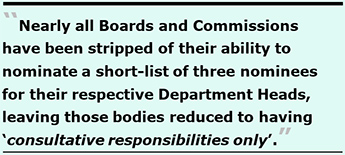 “consultative responsibilities only,” with no real guarantee the Mayor will actually seek consultative input from those bodies before installing a new department head. Other bodies that are not “governance bodies” or “regulatory bodies” have also been stripped of their ability to independently hire Department Heads, also reduced to “consultative” roles.
“consultative responsibilities only,” with no real guarantee the Mayor will actually seek consultative input from those bodies before installing a new department head. Other bodies that are not “governance bodies” or “regulatory bodies” have also been stripped of their ability to independently hire Department Heads, also reduced to “consultative” roles.
It turns out, a chart shows the Mayor currently has “complete authority “ over hiring of only four department heads, and the Mayor is requited to pick department heads from three-nominee “shortlists” for 23 City department heads developed and submitted by Boards and Commissions. The Mayor can appoint two other Department Heads, but must face Board of Supervisors confirmation. [Appointment of another 7 Department’s Heads formerly appointed by the Mayor that have been consolidated as “Divisions” within the City Administrator’s Office may no longer be appointed by the Mayor. But the Mayor does appoint the City Administrator, so the Mayor probably has a say over which Division Heads are picked by the City Administrator.] Perhaps most irksome to the Mayor, “Prop. D” proponents, SPUR, and other “reformers” is that the Mayor currently has no authority over 17 Department Heads picked by Boards and Commissions. Voters elect eight City Department Heads, along with electing the Board of Supervisors.
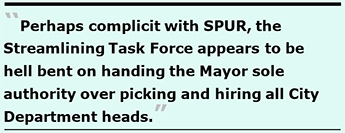 Perhaps complicit with SPUR, the Streamlining Task Force appears to be hell bent on handing the Mayor sole authority over picking and hiring all City Department heads.
Perhaps complicit with SPUR, the Streamlining Task Force appears to be hell bent on handing the Mayor sole authority over picking and hiring all City Department heads.
What’s more, although Ms. Lu didn’t wade into this, the Task Force is wielding its chainsaw over the authority of Commissions to remove their respective Commissioners only “for cause” and handing all power to the Mayor to remove Commissioners “at will” — for no cause whatsoever if the Mayor so chooses.
The Task Force is blithely content to strip away most “seat-level” qualifications for appointments to Boards and Commissions, and replace them with “body-level” qualifications, if any, that will only need a statement from the appointing authority to indicate why any given candidate for appointment is qualified. That effectively strips all “seat level” qualifications that had been designed to provide broad community input on, and possessing specific qualification requirements, where appropriate, for highly specialized Boards and Commissions.
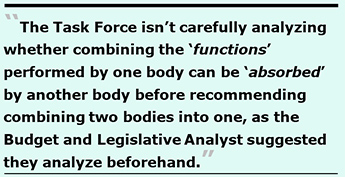 The Task Force isn’t carefully analyzing whether combining the “functions” performed by one body can simply be “absorbed” by another body before recommending combining two bodies into one, as the Budget and Legislative Analyst suggested they analyze beforehand. They have actually made such decisions before receiving a pending analysis of what some bodies actual functions are. What’s worse, the Task Force has potentially assigned functions of some bodies not to another body, but to respective department staff. That will drastically reduce citizen involvement, because City staff will be more reluctant to engage with members of the public than their previous oversight bodies did taking public comment during public meetings.
The Task Force isn’t carefully analyzing whether combining the “functions” performed by one body can simply be “absorbed” by another body before recommending combining two bodies into one, as the Budget and Legislative Analyst suggested they analyze beforehand. They have actually made such decisions before receiving a pending analysis of what some bodies actual functions are. What’s worse, the Task Force has potentially assigned functions of some bodies not to another body, but to respective department staff. That will drastically reduce citizen involvement, because City staff will be more reluctant to engage with members of the public than their previous oversight bodies did taking public comment during public meetings.
And the Task Force’s “Decision Log” isn’t transparently documenting what functions are being handed off to another body vs. to department staff to perform.
The Task Force is wielding its chainsaw, or slingshot, by chopping Commissions out of the City Charter and plopping them into the City’s Administrative code, in a stated purpose to make housecleaning in the future much easier for a subsequent crop of City “streamlining” reformers.
The Task Force has been doing all of this, and more, despite concerns raised by community observers during their meetings, as if the Task Force members are tone deaf. [This may come back to bite them in the back end when the Task Force’s recommendations reach the Board of Supervisors and then the voters when the recommendations are placed on the ballot.]
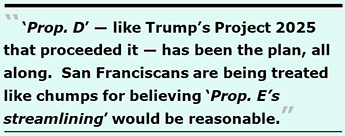 “Prop. D” — like Trump’s Project 2025 that proceeded it — has been the plan, all along. San Franciscans are being treated like chumps for believing “Prop. E’s streamlining” would be reasonable!
“Prop. D” — like Trump’s Project 2025 that proceeded it — has been the plan, all along. San Franciscans are being treated like chumps for believing “Prop. E’s streamlining” would be reasonable!
This Task Force is now obeying the intent of “Prop. D” in practice, and rushing to surrender to it!
It’s shameful that the Streamlining Task Force is ignoring the 207,604 San Franciscans who voted against “Prop. D” and simultaneously ignoring the 192,540 voters who passed “Prop. E.” In addition, while this Streamlining Task Force is voting to eliminate board, commissions, and policy bodies that voters passed to create other bodies in previous years, these five Task Force members believe in their heart of hearts that they have a Donald Trump-like “mandate” to impose their will and beliefs on the hundreds of thousands of San Franciscans who had cast our ballots hoping to create the democratic oversight bodies we deserve to have, but these Task Force members want to hand as a gift to our billionaire Mayor. How Trumpian!
This has become a recipe for disaster that only foxes salivating over the thought of their next chicken dinner with a side dish of feathers, could love! You know, five foxes guarding the hen house.
The Early Meetings
Between February and mid-August, the Task Force spent the majority of its scheduled meetings developing purported evaluation criteria, and quibbling over three main templates to assess what to do with San Francisco’s approximately 150 Boards, Commissions, and advisory bodies.
 The Task Force is forcing all bodies to “align” with the templates’ criteria, granting only rare exceptions, although there can be exceptions to almost any rule! A sample of the templates with the “evaluation criteria” showing the categories of information contained in the template is available here. The templates are applied to each body being evaluated.
The Task Force is forcing all bodies to “align” with the templates’ criteria, granting only rare exceptions, although there can be exceptions to almost any rule! A sample of the templates with the “evaluation criteria” showing the categories of information contained in the template is available here. The templates are applied to each body being evaluated.
The Task Force settled on three main templates: One each for Governance Bodies, Advisory Committees (a.k.a. Policy) Bodies, and Appeals Bodies. The Task Force deliberately chose not to develop “templates” of criteria to evaluate “Regulatory Bodies,” despite the fact that City Administrator staff supporting the Streamlining Task Force had announced on March 19 that 16 of the City’s Board and Commissions in fact have “Regulatory” functions.
The templates are a big deal, because they are not only being used to evaluate the City’s current bodies, the Task Force hopes to “memorialize” the templates to guide the potential creation of new boards, commissions, and advisory bodies in the future, in effect cementing this Task Force’s legacy far into the future — or at least until some new review body decides whether to alter or eliminate completely the entire “templates” construct, potentially as no longer appropriate. [That won’t happen until we get a new Mayor, and/or a more “progressive” Board of Supervisors!] Essentially, the templates will lock in the Board of Supervisors, and/or any City department that wants to create new bodies into having to shoehorn new bodies into alignment with these templates.
During its two meetings in August, the Task Force voted to eliminate 36 inactive and borderline-inactive bodies. Because those deliberations and voting ran long on time while the Task Force quibbled over minutiae, they eliminated three agenda items from their published agendas when their room reservations ran out of time. Those agenda items have not been rescheduled, and likely won’t be.
On August 20, agenda item #6, a preliminary analysis overview the Board of Supervisors’ Budget and Legislative Analyst (BLA) was scheduled to present in a PowerPoint presentation a summary of its initial findings about the financial impact of operating (keeping), eliminating, or consolidating (combining) the City’s public bodies in advance of the BLA’s full report scheduled to be released on September 1 (a legal holiday). The BLA’s PowerPoint presentation wasn’t delivered. That presentation was pulled off the agenda and never presented to Task Force members, so they weren’t given an opportunity to ask any questions about the BLA’s methodologies, or preliminary findings.
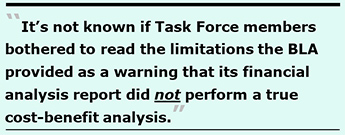 It’s not known whether Task Force members bothered to read the limitations of the financial data collected, and other caveats the BLA provided as a warning in the PowerPoint presentation, that its September 1 financial analysis report did not perform a true cost-benefit analysis.
It’s not known whether Task Force members bothered to read the limitations of the financial data collected, and other caveats the BLA provided as a warning in the PowerPoint presentation, that its September 1 financial analysis report did not perform a true cost-benefit analysis.
The BLA’s PowerPoint presentation noted most respondents to the BLA’s Excel template survey assumed all functions of any bodies being absorbed would remain the same.
Also deleted from the August 20 meeting were agenda items #9 and #10, ”Staff Working Groups” and “Legally Required Bodies,” respectively, both action items, depriving Task Force members with preliminary direction and guidance on how to evaluate those types of bodies during future staff recommendations and Task Force deliberations. Those two agenda items weren’t rescheduled, either.
Finally, agenda item #8 on the “Sheriff’s Department Oversight Board and the Sheriff’s Inspector General” on the September 3 meeting agenda wasn’t heard on its scheduled date, but was rescheduled for the Task Force’s September 17 meeting.
Inadequate Templates Developed
In addition to the Task Force not having developed a separate template for “Regulatory Bodies” — which are being shoehorned into the “Governance” template for evaluations — the Task Force also didn’t develop separate templates for evaluating Workgroup bodies and other miscellaneous bodies.
Worse, as of September 3 when the Task Force began deliberating body-by-body what to do with each body, when it came to evaluating the Juvenile Probation Commission (JPC), the September 3 meeting minutes reported that the Task Force had also not decided when or how a body should be deemed a “Governance Commissions” vs. an “Advisory Body.” They’re deciding that issue on the fly, making things up as they go. So, the Task Force couldn’t decide how to “align” (evaluate) to an applicable template and force changes, if any, to the JPC.
As well, as late as October 1, when it came time to evaluate the Arts Commission and Building Inspection Commission, the Task Force was forced to defer decisions on the implications of converting both commissions from “Governance Commissions” to “Advisory Bodies.” Yet, without knowing the implications, or reviewing the specific functions of either commission, they converted them to “Advisory Bodies” anyway, deferring examining the implications of doing so to a meeting in November and December after assessing all 150 bodies.
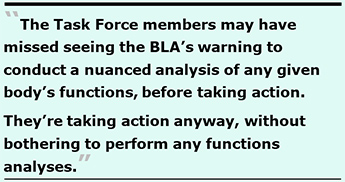 Because the BLA’s PowerPoint presentation and the BLA’s full “Financial Costs Analysis” report wasn’t presented to the Task Force during an actual meeting, the Task Force members may have missed seeing the BLA’s warning to conduct a nuanced analysis of any given body’s functions, before taking action. They’re taking action anyway, without bothering to perform any functions analyses, in classic cart-before-the-horse fashion!
Because the BLA’s PowerPoint presentation and the BLA’s full “Financial Costs Analysis” report wasn’t presented to the Task Force during an actual meeting, the Task Force members may have missed seeing the BLA’s warning to conduct a nuanced analysis of any given body’s functions, before taking action. They’re taking action anyway, without bothering to perform any functions analyses, in classic cart-before-the-horse fashion!
The Task Force faced a similar problem with the “Historic Preservation Commission,” which had initially been classified as a “Regulatory Body.” Implications be damned, the Task Force also voted to defer making a decision on which of the Historic Preservation Commission’s “Regulatory” functions should remain in the City Charter, and which functions be moved to the Administrative Code.
Task Force Meetings to Date
Following development of the templates and evaluation criteria in July to mid-August, the Task Force voted to eliminate 31 bodies identified by the City Attorney and City Administrator as being essentially “inactive.” Then it voted to eliminate another five “borderline inactive bodies,” on the pretext the bodies had not met frequently enough, or had problems recruiting members, affecting reaching quorums to conduct their meetings. So 36 bodies were simply voted out of existence and eliminated, with little to no discussion of the functions, purposes, or costs of any of those bodies.
The Task Force moved on to its first of five scheduled meetings devoted to reviewing body-by-body what to do with the then-remaining 113 City bodies, beginning with its September 3 meeting assessing the 10 bodies in “Public Safety Bodies” policy group category. On September 17, it considered 20 bodies in the “Infrastructure, Climate, and Mobility Bodies” policy group category, including the SFMTA.
It’s third meeting on October 1 considered the 31 bodies in the “Housing and Economic Development Bodies” policy group, including various arts and culture bodies; building and permitting bodies; economic development bodies (such as the Airport, Entertainment, and Small Business Commissions); planning and land use bodies (including the Planning Commission and Historic Preservation Commission); and workforce development bodies.
So far, out of 97 bodies the Task Force has made initial recommendations on, the Task Force eliminated a total of 51 bodies, plus “combined” another three appeals bodies with the Board of Appeals, that the Task Force is creatively categorizing as having been “eliminated,” despite having been “combined.” The Task Force may also creatively assert later that by eliminating those combined 54 bodies it has saved a total of $1.6 million incosts. But that’s completely false, because between the “eliminated” and “combined” bodies, 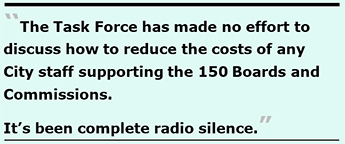 there was zero savings in actual full-time staff “hard costs” savings, and the entire $1.6 million was for part-time staff “soft costs,” which the Legislative Analyst informed the Task Force on September 1 would result in zero savings for the City, since those part-time employees would likely be retained to continue performing their other non-board and commission support job duties.
there was zero savings in actual full-time staff “hard costs” savings, and the entire $1.6 million was for part-time staff “soft costs,” which the Legislative Analyst informed the Task Force on September 1 would result in zero savings for the City, since those part-time employees would likely be retained to continue performing their other non-board and commission support job duties.
As it is, the Task Force has made no effort to discuss how to reduce the costs of any City staff supporting the 150 Boards and Commissions, either for part-time or full-time staff support costs! It’s been complete radio silence.
The top table in a secondary analysis of the potential cost savings to date of the 97 bodies the Task Force has made initial recommendations on through October 1, shows 36.2% of the bodies have been eliminated or combined, with 27.5% of the bodies being kept, and made no recommendation on what to do with two other bodies (the “Joint Zoo Committee” governed by a “Memorandum of Understanding” as a public-private partnership between the Zoo and the Recreation and Parks Department, and the “Sentencing Commission” in the Public Safety category).
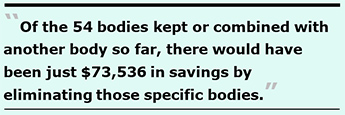 The $1.6 million in potential cost savings is also misleading, precisely because Appendix 6 in the BLA’s full report said that of the 54 bodies kept or combined with another body so far, there would have been just $73,536 in savings by eliminating those specific bodies. It’s clear the difference between the $1.6 million reported in Appendix 4 vs. Appendix 6 in the BLA’s report involves the fact that the part-time staff “soft costs” are not going to result in any net savings — as the “Prop. D” proponents and backers had seminal fluid dreams about, and there may be no real net savings to the City from the $73,536 “estimate,” either.
The $1.6 million in potential cost savings is also misleading, precisely because Appendix 6 in the BLA’s full report said that of the 54 bodies kept or combined with another body so far, there would have been just $73,536 in savings by eliminating those specific bodies. It’s clear the difference between the $1.6 million reported in Appendix 4 vs. Appendix 6 in the BLA’s report involves the fact that the part-time staff “soft costs” are not going to result in any net savings — as the “Prop. D” proponents and backers had seminal fluid dreams about, and there may be no real net savings to the City from the $73,536 “estimate,” either.
The bottom table in the linked secondary analysis was updated on October 4 to incorporate the Task Force’s 132-page set of recommendations saved at 10:15 p.m. on October 3 and distributed by e-mail and posted on-line at 10:00 a.m. on October 4. We’ll have to see what decisions the Task Force actually make on October 15, and how many of the preliminary “combine or eliminate” recommendations for 8 bodies end up actually being eliminated vs. combined.
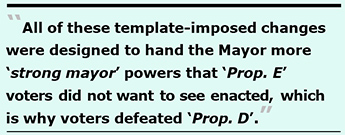
For Westside Observer readers with the time, interest, and stamina, the Task Force’s “Decision Log” updated on October 2 shows on pages 14 and 15 the outcomes decisions made at during each of the Task Force’s meetings between July 16 and October 1.
October 1 Chopping Block
Of 31 bodies discussed during the Task Forces October 1 meeting in the “Housing and Economic Development” policy area category three bodies — the Abatement Appeals Board, Access Appeals Commission, and Board of Examiners — were “combined” with the Board of Appeals. [The Task Force’s “Decision Log” now creatively labels their outcome as “eliminated,” which is a misnomer and misleading.] Those three bodies dealing with building and entertainment venue permits and licenses will likely have to begin paying fees in order to file appeals with the Board of Appeals.
The seven bodies eliminated on October 1 include Bayview Hunters Point Citizens Committee on Community Development, Market and Octavia Community Advisory Committee, and Street Artists and Craftsmen Advisory Committee, among others. The Task Force is hell-bent on eliminating advisory bodies as often as it can, particularly “Citizens Advisory Committees” (CAC’s).
 The Task Force kept 21 of the 31 bodies on October 1, including the Arts Commission, Building Inspection Commission, Entertainment Commission, Film Commission, Historic Preservation Commission, Planning Commission, and Rent Board, among others.
The Task Force kept 21 of the 31 bodies on October 1, including the Arts Commission, Building Inspection Commission, Entertainment Commission, Film Commission, Historic Preservation Commission, Planning Commission, and Rent Board, among others.
But by applying the various templates, the Task Force stripped some of these bodies from being able to nominate and select their respective Department Heads, and handed the hiring and firing authority to the Mayor, with the bodies only being offered a hollow “consultative responsibilities only” role and losing their ability to provide a “short list” of three qualified nominees. Some of these bodies were yanked out of the City Charter and plopped into the Admin Code to make it easier to eliminate them more easily in the future. Other “template” changes applied to them include enacting term lengths and term limits, and allowing commission members to be removed at will, rather than for cause.
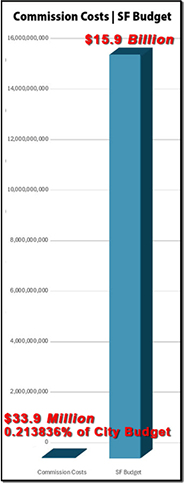 All of these template-imposed changes were designed to hand the Mayor more “strong mayor” powers that "Prop. E” voters did not want to see enacted, which is why voters defeated “Prop. D.”
All of these template-imposed changes were designed to hand the Mayor more “strong mayor” powers that "Prop. E” voters did not want to see enacted, which is why voters defeated “Prop. D.”
Because the Streamlining Task Force plays fast and loose avoiding discussion of what to do with the “functions” and duties of these bodies, San Franciscan’s should probably lower their expectations that promises made in previous ballot measures creating these bodies will have any meaningful oversight retained and performed with citizen-led members.
Readers wanting to see details of how these bodies are being significantly altered by being forced into “alignment “with the templates will have to read the 16-page (and growing) “Decision Log” updated after each Task Force meeting for specific details. Readers may also want to read the Task Force’s meeting minutes to follow other changes that may not be recorded in the “Decision Log.”
Up until October 1, Task Force members hadn’t discussed any of the costs associated with any of the bodies they had issued initial recommendations on. In fact, only once did City Administrator staff even bother to mention projected savings for just one body facing elimination — and that body was eventually retained.
Next Two Meetings
As for the remaining 54 bodies — 30 bodies in the “Health and Wellbeing” policy category, and the 23 bodies in the “General Administration and Finance” policy category — we’ll have to see if during the Task Force’s next two meetings whether those bodies will face a will face a similar split of percentages being kept vs. eliminated. If the percentages hold constant, that may portend the elimination of another 19 bodies, for a total of 73 eliminated or combined, well above the 65 bodies the “Prop. D” backers had wanted gutted — lending credence to “Prop. E” voters current concerns that the “Prop. E” Commission Streamlining Task Force are wielding a “Prop D”-style chainsaw and sledgehammer!
The October 15 meeting on outcomes for 30 bodies in the “Health and Wellbeing” category, recommends keeping 17 bodies, including the Behavioral Health Commission, Children and Families First Commission, Commission on Aging Advisory Council, Commission on the Status of Women, Health Commission, Human Rights Commission, and Disability and Aging Services Commission, and a handful of other bodies.
Many of the changes affecting composition, authority, and functions of these boards and commissions noted above made by applying the various templates will also happen to the “Health and Wellbeing” bodies.
The other 13 bodies facing being eliminated or combined on October 15 include the Dignity Fund Oversight and Advisory Committee, Early Childhood Community Oversight and Advisory Committee, Homelessness Oversight Commission, Long Term Care Coordinating Council, and the Our Children Our Families Council, among others.
Then in its last meeting to decide body-by-body decisions, the Task Force is set to hear 23 bodies in the “General Administration and Finance” category on November 5. Among those bodies are the Assessment Appeals Board, Citizens’ General Obligation Bond Oversight Committee, Elections Commission, Ethics Commission, City Employees Retirement Board, Sunshine Ordinance Task Force, SFMTA Bond Oversight Committee, and the Commission Streamlining Task Force itself, among others.
Because two of the current five members of the Commission Streamlining Task Force don’t meet the qualifications to hold their respective “seats” and because this Task Force has all but eliminated “seat-level” qualifications for most other appointed members on other Boards and Commissions in favor of “body-level” qualifications, I’m placing my money on a bet the Task Force decides to eliminate the “seat-level” qualifications for seats they occupy on the Commission Streamlining Task Force! Any takers?
Task Force Member Biases
As noted, two Task Force members aren’t qualified for the seat they hold. Task Force Chair Ed Harrington in Seat 4 appointed by the President of Board of Supervisors was supposed to be a representative of organized labor representing the public sector. Harrington does not have that experience. Sophia Kittler (and Jean Fraser before Kittler) appointed to Seat 5 by the Mayor, were supposed to be an “Open Government Expert” as a person with expertise in open and accountable government. Neither Kittler nor Fraser possess that qualification or experience.
Instead Kittler’s employment experience has been in private sector development (given her master’s degree focus on private sector development) and public-sector budget management.
Perhaps on cue, just after being sworn in to replace Jean Fraser on the Commission Streamlining Task Force as the Mayoral appointee, Mayor Lurie’s Budget Director, Sophia Kittler, showed up for her inaugural Task Force meeting on September 17.
Then, Kittler went missing in action at the Task Force’s next meeting on October 1. For her part, Ms. Fraser had attended the first two of the five body-by-body deliberation meetings before suddenly resigning, claiming in her September 10 resignation letter that she couldn’t meet the time commitment to the Task Force. It will be interesting to see if Kittler is a no-show at the last two of the five scheduled body-by-body review meetings.
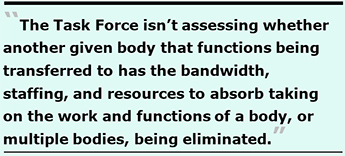 Task Force members’ have not been presented with, or assessed, the functions of bodies they are deciding the fate of before decision-making. As noted above, the BLA had warned the Task Force to conduct a nuanced analysis of any given body’s functions. The Task Force hasn’t bothered itself performing that functions analysis! And the Task Force isn’t assessing whether another given body that functions being transferred to has the bandwidth, staffing, and resources to absorb taking on the work and functions of a body, or multiple bodies, being eliminated.
Task Force members’ have not been presented with, or assessed, the functions of bodies they are deciding the fate of before decision-making. As noted above, the BLA had warned the Task Force to conduct a nuanced analysis of any given body’s functions. The Task Force hasn’t bothered itself performing that functions analysis! And the Task Force isn’t assessing whether another given body that functions being transferred to has the bandwidth, staffing, and resources to absorb taking on the work and functions of a body, or multiple bodies, being eliminated.
When it came to the Rent Board, the Task Force had recommended that appeals of Rent Board Administrative Law Judges decisions be transferred to the Board of Appeals. The Westside Observer presented written testimony noting that if that had been enacted, both tenants and landlords would have faced steep Board of Appeals fees to have any appeals heard by the Board of Appeals, that they have not had to pay in the 46 years since the Rent Board was created in June 1979.
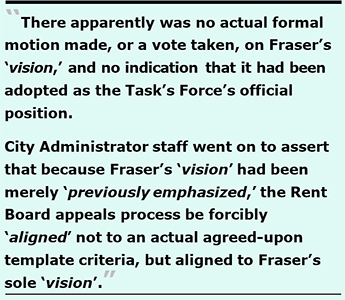 City Administrator staff claimed in its “Staff Discussion” recommendation report that the Task Force had “previously emphasized that appeals bodies should be independent from the City departments whose decisions they review.” The Westside Observer was unable to locate any records that the Task Force had even discussed that issue, or had arrived at such a consensus decision. In response to a records request placed by the Westside Observer for any such decision previously made, the City Administrator’s Office on behalf of the Task Force stonewalled, claiming it would respond to the records request by October 9. We’re still waiting for that response.
City Administrator staff claimed in its “Staff Discussion” recommendation report that the Task Force had “previously emphasized that appeals bodies should be independent from the City departments whose decisions they review.” The Westside Observer was unable to locate any records that the Task Force had even discussed that issue, or had arrived at such a consensus decision. In response to a records request placed by the Westside Observer for any such decision previously made, the City Administrator’s Office on behalf of the Task Force stonewalled, claiming it would respond to the records request by October 9. We’re still waiting for that response.
[Note: The response received on October 8 cited only a passing reference in the Task Force’s June 4 meeting minutes that reported Vice Chair Fraser had “recommended [her vision] that appeals bodies be independent of the [City] departments they review and resistant to political interference.” There apparently was no actual formal motion made, or a vote taken, on Fraser’s “vision,” and no indication that it had been adopted as the Task’s Force’s official position. But City Administrator staff went on to assert that because Fraser’s “vision” had been merely “previously emphasized,” the Rent Board appeals process should fall into line, and be forcibly “aligned” not to an actual agreed-upon template criteria, but aligned to Fraser’s sole “vision.” Like Donald Trump, the Task Force is just making stuff up as they go along, inventing magical rules.]
The claim there is a need to create more separation and “neutrality” by forcing appeals to be independent from a City Department involved is a smokescreen, perhaps made up out of whole cloth.
Thankfully, the Rent Board’s appeals process was retained as currently structured, and not transferred to the Board of Appeals.
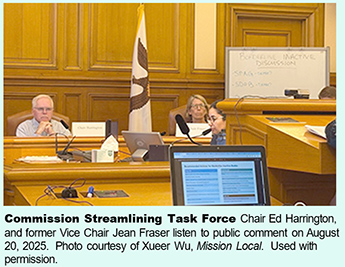 Harrington’s and Fraser’s SPUR Roots
Harrington’s and Fraser’s SPUR Roots
Both Harrington and Fraser are Board members of SPUR. Fraser, who earned her law degree from Yale University, was a former Deputy City Attorney in San Francisco.
One of the first documents presented to the Streamlining Task Force was a 68-page presentation titled “Designed to Serve” that SPUR presented to the Task Force on March 19, 2025, most likely at Jean Fraser’s or Ed Harrington’s insistence. The 68 pages were split between a 44-page main report written in August 2024 and updated in September 2024 leading up to the November election, and an accompanying 24-page PowerPoint presentation subtitled “Resetting the city’s governance structure to better serve the people of San Francisco.” The presentation appears to have been written following the election.
[Note: Remarkably, the metadata for the PowerPoint presentation carries no author name, and astonishingly, no creation or modification dates, nor did the 44-page main report list an author’s name. The PowerPoint file “Document Properties” metadata screen does contain a title line reading “Prop E Taskforce Presentation,” suggesting it was specifically written for the Streamlining Task Force. But how (and why) do you create a PDF file and hide or suppress on what date it was created or last modified? Why do that? Perhaps SPUR can answer that question.]
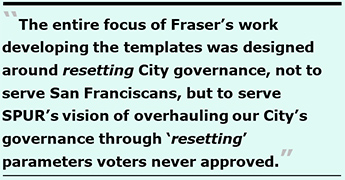 The presentation’s subtitle said it all: The entire focus of Fraser’s work developing the templates was designed around resetting City governance, not to serve San Franciscans, but to serve SPUR’s vision of overhauling our City’s governance through “resetting” parameters voters never approved! That had been Fraser’s goal all along, to serve not us, but her benefactors! Her, and this Task Force’s, goals could not have been made any clearer.
The presentation’s subtitle said it all: The entire focus of Fraser’s work developing the templates was designed around resetting City governance, not to serve San Franciscans, but to serve SPUR’s vision of overhauling our City’s governance through “resetting” parameters voters never approved! That had been Fraser’s goal all along, to serve not us, but her benefactors! Her, and this Task Force’s, goals could not have been made any clearer.
Notably, the presentation clearly stated on slide 11, that SPUR’s third recommendation was to “Restore the mayor’s authority to hire and fire most department heads.” Somewhat shockingly, SPUR’s eighth recommendation on slide 13 was to “Raise the bar to put ballot measures before voters,” (i.e., new barriers).
Of interest, both Harrington and Ms. Fraser were listed — along with former City Controller, Ben Rosenfield — on the PowerPoint presentation as having been members of a separate eight-member Task Force prior to the November 2024 election that had developed SPUR’s recommendations on “resetting the city’s governance structure.” It couldn’t get any cozier than that.
 Despite Harrington’s admonishments to his fellow Task force members that “Prop. E” was to be about streamlining — not overhauling or “resetting” — City governance, his protestations ring hollow!
Despite Harrington’s admonishments to his fellow Task force members that “Prop. E” was to be about streamlining — not overhauling or “resetting” — City governance, his protestations ring hollow!
Fraser was the chief architect in forcing the Streamlining Task Force to develop and adopt the so-called “templates” the Task Force is now using to force all of San Francisco’s 150 Boards and Commissions to “align” to. We can thank Fraser and SPUR for the blind allegiance to the templates.
SPUR (San Francisco Bay Area Planning and Urban Research Association) is a nonprofit public policy organization that claims it promotes good 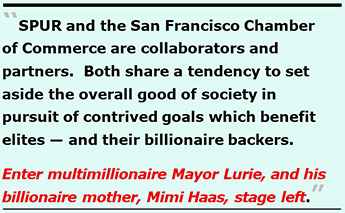 planning and good government in the Bay Area. It was primarily formed to advocate for policy changes to improve urban planning, not to focus principally on “good government.”
planning and good government in the Bay Area. It was primarily formed to advocate for policy changes to improve urban planning, not to focus principally on “good government.”
SPUR and the San Francisco Chamber of Commerce are collaborators and partners, with the Chamber of Commerce advocating for businesses and economic development. Both are conservative groups that share a tendency to set aside the overall good of society in pursuit of contrived goals which benefit elites — and their billionaire backers. Enter multimillionaire Mayor Lurie, and his billionaire mother, Mimi Haas, stage left.
Voters passed “Prop. E” believing we can never have too little democracy and too little democratic processes. Some observers have concluded that, unfortunately, citizen participation in San Francisco’s governance structure and Boards and Commissions may stand in the way of SPUR’s, Ms. Fraser’s, and Mayor Lurie’s way — who all insist on having a “strong mayor,” voters be damned.
The ultimate end goal of this Streamlining Task Force may well be to restrict San Franciscans’ ability to place future 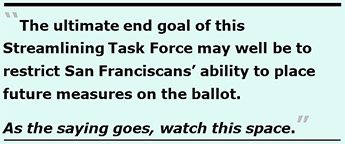 measures on the ballot, but that may not be sprung on unsuspecting members of the public until the Task Force’s final recommendations are published sometime in December. As the saying goes, watch this space.
measures on the ballot, but that may not be sprung on unsuspecting members of the public until the Task Force’s final recommendations are published sometime in December. As the saying goes, watch this space.
How San Franciscans Are Participating
Public participation so far in the Streamlining Task Force’s deliberations during meetings has been widespread. As a table compiled by the Westside Observer illustrates, during eight Task Force meetings held between March 19 and September 17, 148 people have presented oral testimony during those meetings. In addition, the Task Force has received at least 203 written letters of testimony from members of the public for 10 meetings between March 19 and October 15, almost all of them of opposing how the Streamlining Task Force is drastically changing how San Francisco’s Boards and Commissions currently function.
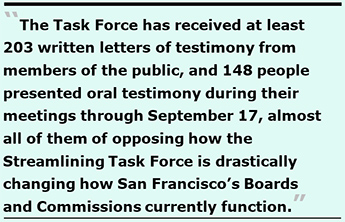 And nearly all of the public speakers and written testimony submitted have opposed the Task Force’s efforts to weaken commissions in ways that are similar, or identical to what the “Prop. D” proponents and backers had wanted to be accomplished to hand the Mayor stronger powers and dismantle citizen participation. The Task Force has received a bare handful of letters supporting actions they have taken.
And nearly all of the public speakers and written testimony submitted have opposed the Task Force’s efforts to weaken commissions in ways that are similar, or identical to what the “Prop. D” proponents and backers had wanted to be accomplished to hand the Mayor stronger powers and dismantle citizen participation. The Task Force has received a bare handful of letters supporting actions they have taken.
Between October 15 and December when the Task Force is scheduled to develop and present its draft report and final recommendations, members of the public need to get involved rapidly, if they already haven’t. You can do so by submitting written testimony to Task Force Chair Harrington and the other four Task Force members via e-mail to CommissionStreamlining@sfgov.org and to Rachel.Alonso@sfgov.org, the City Administrator’s project director providing administrative support to the Task Force.
You can also request to be added to the Task Force’s official mailing list to receive meeting agendas in advance, and other notices. Requests to be added or removed from the mailing list should be sent to commissionstreamlining@sfgov.org.
Get involved now, before it’s too late. It’s now, or never.
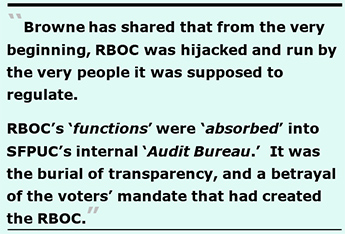 A Cautionary Tale …
A Cautionary Tale …
“Proposition P” in 2002 was put on the ballot to create a citizen-led “Revenue Bond Oversight Committee” (RBOC) as a watchdog over the SFPUC, which is self-regulated — which means it is effectively unregulated. RBOC was designed to close that gap and provide the public with true, independent oversight.
My Westside Observer colleague, Brian Browne, was the author of, and the primary ballot measure proponent of, “Prop. P.” He served on RBOC for a number of years.
As of mid-2025, the SFPUC has reportedly issued over $8.5 billion in outstanding borrowing, most of which has been through revenue bonds.
Browne has shared that from the very beginning, RBOC was hijacked and run by the very people it was supposed to regulate. That hijacking was relentless. San Francisco officials apparently decided it was easier to erase the RBOC when the Board of Supervisors recommended sunsetting RBOC in January 2025, than to allow public oversight and accountability.
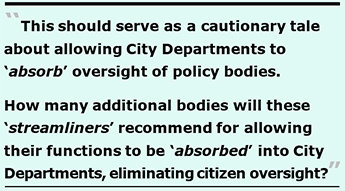 RBOC’s “functions” were shifted — a.k.a., “absorbed” — into SFPUC’s internal “Audit Bureau,” which holds no public meetings. That wasn’t DOGE-style reform, or government efficiency. According to Mr. Browne, it was the burial of transparency, and a betrayal of the voters’ mandate, since 64% of San Francisco voters had passed “Prop. P.” Unfortunately, our current crop sitting on San Francisco’s Board of Supervisors gave the green light to eliminating RBOC (including former D-4 Supervisor Joel Engardio, who thankfully just lost is recall election on September 15)! Engardio had attended the “Prop. D” campaign kick-off launch event outside City Hall, along with State Senator Scott Wiener and “Prop. D" proponent Kanishka Cheng.
RBOC’s “functions” were shifted — a.k.a., “absorbed” — into SFPUC’s internal “Audit Bureau,” which holds no public meetings. That wasn’t DOGE-style reform, or government efficiency. According to Mr. Browne, it was the burial of transparency, and a betrayal of the voters’ mandate, since 64% of San Francisco voters had passed “Prop. P.” Unfortunately, our current crop sitting on San Francisco’s Board of Supervisors gave the green light to eliminating RBOC (including former D-4 Supervisor Joel Engardio, who thankfully just lost is recall election on September 15)! Engardio had attended the “Prop. D” campaign kick-off launch event outside City Hall, along with State Senator Scott Wiener and “Prop. D" proponent Kanishka Cheng.
Browne says: “This was never about efficiency. It was about hiding inconvenient truths and protecting the powerful.”
He says the story cannot be fully vented without details of the subversion — falsified RBOC meeting minutes, illegal maneuvers, acting without RBOC committee protocols, and the continual betrayal of the voters’ will. At age 90, he’s working on a thorough review of the hell he endured for more than eight years, because it’s time the record is set straight.
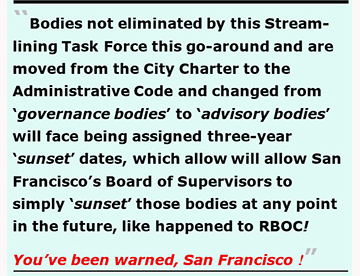 This should serve as a cautionary tale about allowing City Departments to “absorb” oversight of policy bodies. And it is a warning about might become of San Francisco’s “Citizen’s General Obligation Bond Oversight Committee” (CGOBOC) that is charged with monitoring every G.O. Bond put before San Francisco voters, also numbering in the billions of dollars to fund key City infrastructure projects — everything from affordable housing bonds, to Parks bonds, the Laguna Honda Hospital and SFGH rebuild projects and other healthcare facilities, and bonds for SFDPW’s road and street repairs.
This should serve as a cautionary tale about allowing City Departments to “absorb” oversight of policy bodies. And it is a warning about might become of San Francisco’s “Citizen’s General Obligation Bond Oversight Committee” (CGOBOC) that is charged with monitoring every G.O. Bond put before San Francisco voters, also numbering in the billions of dollars to fund key City infrastructure projects — everything from affordable housing bonds, to Parks bonds, the Laguna Honda Hospital and SFGH rebuild projects and other healthcare facilities, and bonds for SFDPW’s road and street repairs.
The fate of CGOBOC will be discussed and initially decided during the Streamlining Task Force’s November 5 meeting. There were still 84 bodies to be decided following the Task Force’s September 17 meeting. How many additional bodies will these “streamliners” recommend allowing their functions to be “absorbed” into City Departments, eliminating all citizen oversight?
Bodies not eliminated by this Streamlining Task Force this go-around (next January) and are moved from the City Charter to the Administrative Code and changed from “governance bodies” to “advisory bodies” will face being assigned three-year “sunset” dates, which allow San Francisco’s Board of Supervisors to simply “sunset” those bodies at any point in the future, just as the City Supervisors did to the RBOC.
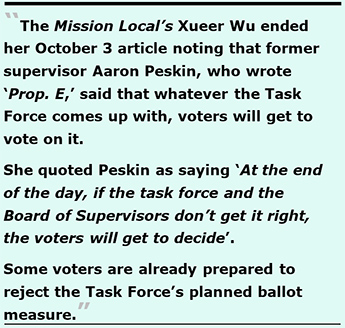 You’ve been warned, San Francisco!
You’ve been warned, San Francisco!
The Mission Local’s Xueer Wu ended her October 3 article noting that former supervisor Aaron Peskin, who wrote “Prop. E,” said that whatever the Task Force comes up with, voters will get to vote on it.
She quoted Peskin as saying “At the end of the day, if the task force and the Board of Supervisors don’t get it right, the voters will get to decide.”
Based on the radical “Prop. D” strong mayor changes the Task Force has recommended so far, some voters are already prepared to reject the Task Force’s planned ballot measure, if the Board of Supervisor’s don’t reject the recommendations themselves!
Monette-Shaw is a columnist for San Francisco’s Westside Observer newspaper, and a member of the California First Amendment Coalition (FAC) and the ACLU. He operates stopLHHdownsize.com. Contact him at monette-shaw@westsideobserver.com.